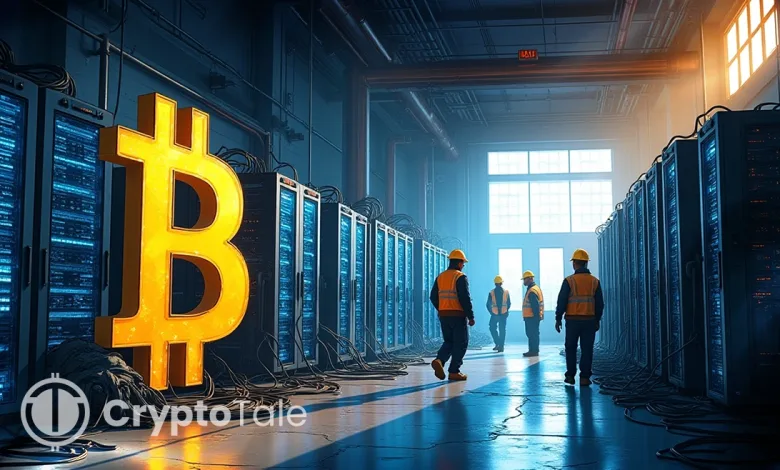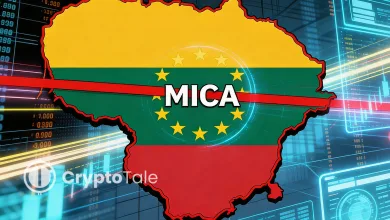70% of Top Bitcoin Miners Generate Revenue from AI and HPC

- Most major bitcoin miners now earn steady revenue from AI and high-performance computing.
- Investors value miners more for AI hosting contracts and power assets than for Bitcoin output.
- Hybrid GPU hosting and mining models help miners manage costs and sustain profitability.
Top Bitcoin mining firms now treat artificial intelligence as a core business line, not a side project. Seven of the ten largest miners by hashrate already generate revenue from AI or high-performance computing (HPC), while the remaining three prepare similar moves, according to recent sector data.
This pivot allows miners to reuse energized land, substations, and fiber links to host GPU clusters, creating a second revenue stream that competes directly with running ASIC machines at full power.
Bitcoin miners pivot to AI data centres and GPU hosting
TeraWulf set a reference point in this transition after signing two 10-year hosting deals with Fluidstack for about 200 megawatts (MW) at its Lake Mariner site. The arrangement, partly backed by Google through lease guarantees, implies around $1.85 million in annual revenue per MW over the term, which other miners now use as a benchmark when negotiating AI contracts.
Core Scientific expanded a long-standing relationship with CoreWeave, adding roughly 70 MW of HPC capacity under a 12-year agreement. Iris Energy and Bitdeer already operate AI cloud platforms built on NVIDIA H100 and H200 systems, while Cipher Mining, CleanSpark, Marathon Digital, and Phoenix Group pursue large campuses and international joint ventures to support mixed Bitcoin and AI workloads.
At today’s network hashrate, one MW of modern ASICs can produce an estimated $1.0 million to $1.6 million in annual mining revenue before power and operating costs. In contrast, the TeraWulf benchmark suggests that high-density AI hosting can reach about $1.85 million per MW per year, highlighting why management teams now compare every new MW between GPUs and ASICs.
Analysts point out that long-term AI contracts also smooth cash flows, which often appeal more to equity investors than volatile block rewards and transaction fees. This change in revenue quality now influences how markets rank miners, not just by exahash but also by contracted AI megawatts and dollars per MW.
AI hosting economics and power assets reshape miner valuations
Research from Bernstein and other firms indicates that large U.S. miners increasingly earn their valuations from power assets and AI data-centre potential rather than pure Bitcoin exposure. The reports describe miners as crucial suppliers of “warm shells” for AI clusters, because they already control power-dense interconnections and permitted sites that face fewer delays than greenfield developments.
Bernstein estimates that miners trade at much higher multiples when they hold active AI contracts, with some names priced at about $6 million per planned megawatt compared with around $3 million for pure mining operations. In that framework, Riot’s 1 GW Corsicana project and Core Scientific’s AI segment contribute a large share of projected enterprise value, despite limited current revenue from some facilities.
The financing side reflects the scale of these build-outs. Publicly listed miners raised several billion dollars in late 2024 and 2025 through debt and convertible notes to fund AI and HPC expansion, according to industry trackers. Some issues carry zero-coupon terms, but others impose interest costs that exceed recent annual revenue, which increases pressure on management teams to ramp AI capacity and hit utilization targets.
Consultants and utilities also expect data-centre demand to grow sharply. McKinsey projects that U.S. data-centre power consumption could reach about 606 terawatt-hours by 2030, while Texas grid operator ERCOT forecasts record peak demand as data-centre loads climb. These projections support miners’ argument that energized sites, substations, and grid connections now function as scarce inputs for the wider AI infrastructure build-out.
Related: French lawmakers Propose Bitcoin Mining With Surplus Energy
Hybrid Bitcoin–AI model changes sector risk and growth profile
The hybrid model, where miners split capacity between Bitcoin and AI, now shapes expectations for network growth. If a significant share of new power flows into GPU hosting instead of ASIC fleets, the global hashrate may continue to rise but at a slower pace than in previous cycles. That scenario could ease pressure on mining margins over time, though it depends on Bitcoin price moves and future fee dynamics.
At the same time, the sector carries fresh risks. Higher leverage exposes miners to interest-rate swings and execution delays on AI projects, while tight transformer supplies, interconnection queues, and GPU availability can hold back revenue. Analysts note that investors now monitor contracted AI megawatts, power pricing, and average dollars per MW alongside traditional metrics such as exahash and energy efficiency.




